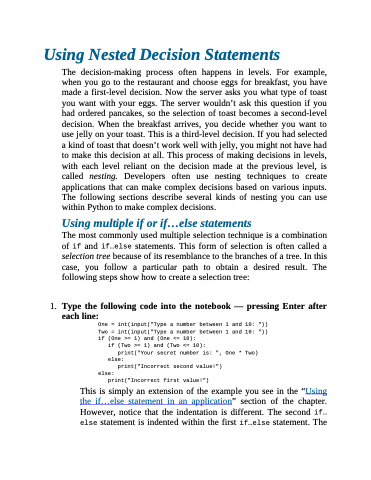Page 178 - Beginning Programming with Pyth - John Paul Mueller
P. 178
Using Nested Decision Statements
The decision-making process often happens in levels. For example, when you go to the restaurant and choose eggs for breakfast, you have made a first-level decision. Now the server asks you what type of toast you want with your eggs. The server wouldn’t ask this question if you had ordered pancakes, so the selection of toast becomes a second-level decision. When the breakfast arrives, you decide whether you want to use jelly on your toast. This is a third-level decision. If you had selected a kind of toast that doesn’t work well with jelly, you might not have had to make this decision at all. This process of making decisions in levels, with each level reliant on the decision made at the previous level, is called nesting. Developers often use nesting techniques to create applications that can make complex decisions based on various inputs. The following sections describe several kinds of nesting you can use within Python to make complex decisions.
Using multiple if or if...else statements
The most commonly used multiple selection technique is a combination of if and if...else statements. This form of selection is often called a selection tree because of its resemblance to the branches of a tree. In this case, you follow a particular path to obtain a desired result. The following steps show how to create a selection tree:
1. Type the following code into the notebook — pressing Enter after
each line:
One = int(input("Type a number between 1 and 10: "))
Two = int(input("Type a number between 1 and 10: "))
if (One >= 1) and (One <= 10):
if (Two >= 1) and (Two <= 10):
print("Your secret number is: ", One * Two)
else:
print("Incorrect second value!")
else:
print("Incorrect first value!")
This is simply an extension of the example you see in the “Using the if...else statement in an application” section of the chapter. However, notice that the indentation is different. The second if... else statement is indented within the first if...else statement. The


